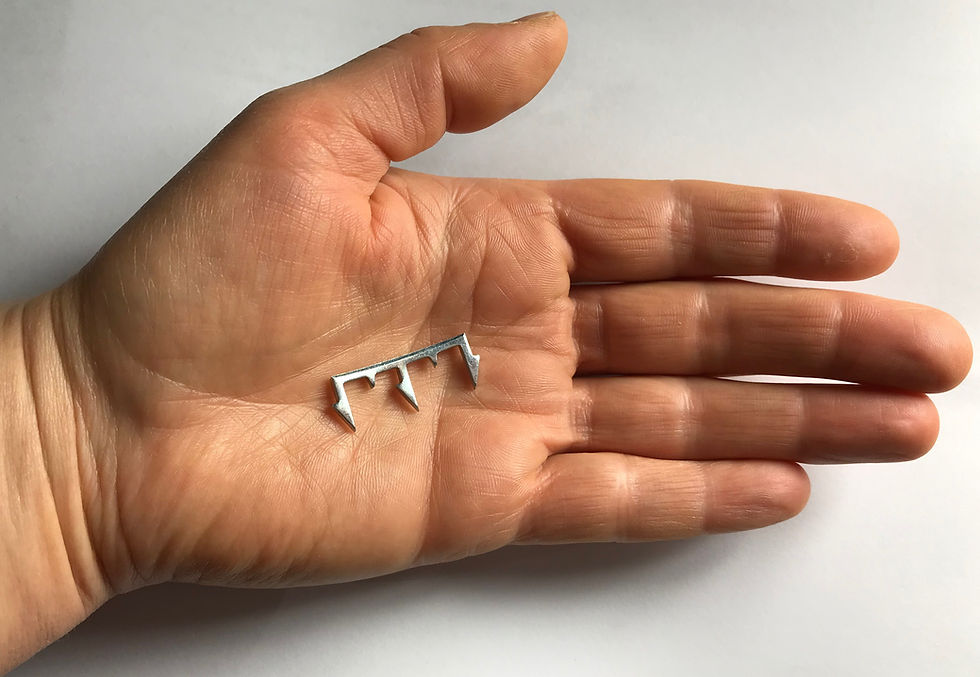D.E. Hoof Taps for Barefoot Horses?
- Beccy Smith CEO & founder

- Dec 5, 2018
- 3 min read
Updated: Jan 9, 2019
Every now and then something new comes on the market that really makes hoof geeks sit up and take notice. These little hoof taps do just that! This article will outline what these can do to help the equine podiatrist, barefoot trimmer, or farrier improve the health and performance of the barefoot horse. And they're not just for barefoot horses; they can be used under shoes, glue-ons, boots and hoof wear too!

Hoof taps help stabilize problem hoof walls
Quarter cracks such as this one can be the barefoot hoof carers nightmare! Traditional remedies often include the application of some form of shoe which helps create stability to the hoof wall. But there are a few challenges with taking this route; namely the environment afforded by the shoe may not provide the correct stimulus required to return health to the foot and hoof, so the underlying cause for the crack can remain unresolved and the crack can return upon removal of the shoe. Secondly, owners who have chosen to keep their horses barefoot rarely want to resort to shoeing if this is the solution presented to them by their hoof carer.

One fairly new solution is to use hoof taps to help control distortion. Quite simply, the tap helps bind section of tubules together above the problem area and provide the stimulus to stabilize the hoof wall and encourage healthy growth. Furthermore, they do not interfere with foot function and facilitate a return to health and performance.
According to Doug Ehrmann; inventor of D.E. hoof taps and long-time farrier; zinc is said to attract existing bacteria and repel new bacteria. Ehrmann’s hypothesis is that if the tap is inserted into a compromised foot - then the zinc coating will draw the bacteria towards itself. In turn, it’s believed that the zinc aids in rerouting the bacteria from traveling up the tubules of the hoof wall. A weak hoof wall is further compromised by bacteria so the hoof taps aid in breaking the cycle and helping healthy wall grow in.
Hoof taps offer a cost effective solution to owners of barefoot horses
According to www.soundequine.net; hoof taps were tested in the farrier school at Cornell University College of Veterinary Medicine in New York, where instructor Steve Kraus, CJF described D.E hoof taps as
“a less costly way to keep barefoot hooves from falling apart, or to help grow out cracks.”
In addition, they can replace hoof boots, hoof wear, shoes and other solutions to prevent against excessive wear and help control distortion precisely where it is needed. A horse can wear one or several taps and they are inexpensive; certainly when compared to other appliances and solutions to common hoof problems such as, low or under-run heels, wall separations and excessive or uneven wear. They need to be fitted by a suitably qualified hoof care professional and can be purchased from www.equinepodiatry.com and other suppliers.
Some facts about D.E. hoof taps
each tap has an anti-bacterial coating and three shallow anchors and is 1.25 inches in length
placed into the outer wall, the taps control distortion in the tubules - creating proper stimulus for stability
the taps encourage tighter new wall growth and healthier white line
the taps can be placed in the quarters, the toe and forward of the seat of corn
they are practically invisible once fitted and only promote healthy foot function
they may be covered by any kind of shoe, glue-ons, hoof wear or boots
they can be left uncovered in the barefoot horse
they may help the transitioning horse go barefoot
taps may be a viable option to shoes or other appliance

What problems or conditions may be helped by hoof taps?
they can help in the treatment of young club footed horses
when used forward of the seat of corn they can help prevent migration
as a result of improved stability they may help with conditions such as navicular syndrome or equine osteoarthritis where unhealthy distortion is an issue
when used behind break-over they can prevent wall separation
where there is infection or loss of tissue creating loss of stability/excess distortion
by preventing uneven and excessive wear, they can help with balance issues and loss of performance
traction may be improved in certain conditions
Further reading can be found at www.soundequine.net and www.equinepodiatry.com
If you would like to discuss D.E. hoof taps for your horse, contact your hoof care professional.
Holistic Reflections provide Applied Equine Podiatry consultations. If you would like to learn more about our top quality holistic hoof care services, would like to maintain or improve your horses performance or would like to book an AEP consult with Beccy, please feel free to contact us today!
We also welcome feedback or comments so please feel free to leave a message.
Warmest well wishes,
Beccy Smith BSc(Hons) EBW DAEP








Comments